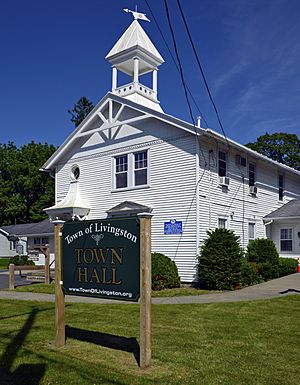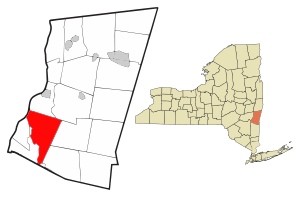Livingston, New York facts for kids
Quick facts for kids
Livingston, New York
|
|
|---|---|

Town hall, 2019
|
|

Location of Livingston, New York
|
|
| Country | United States |
| State | New York |
| County | Columbia |
| Government | |
| • Type | Town Council |
| Area | |
| • Total | 38.95 sq mi (100.87 km2) |
| • Land | 38.16 sq mi (98.84 km2) |
| • Water | 0.78 sq mi (2.03 km2) |
| Elevation | 217 ft (66 m) |
| Population
(2020)
|
|
| • Total | 3,628 |
| • Density | 93.145/sq mi (35.967/km2) |
| Time zone | UTC-5 (Eastern (EST)) |
| • Summer (DST) | UTC-4 (EDT) |
| ZIP code |
12541
|
| Area code(s) | 518 |
| FIPS code | 36-021-42917 |
| GNIS feature ID | 0979160 |
Livingston is a small and friendly town located in Columbia County, New York, in the United States. In 2020, about 3,628 people lived here. The town got its name from the person who helped start it.
You can find Livingston in the southwestern part of Columbia County. A main road called U.S. Route 9 goes right through the town.
Contents
History of Livingston
Before 1686, the land where Livingston is now was part of a Dutch trading area. This area was called New Netherlands. It stretched along the Hudson River. In 1664, the British took control of this land.
How Livingston Was Founded
The land for Livingston Manor was given to Robert Livingston in 1686. This was a special land grant. In 1772, the area became a "district." Then, in 1788, the town of Livingston was officially created. It was one of the first towns in Columbia County.
Early Settlers
In 1710, many Palatine Germans came to live in this area. They were settlers from Germany.
Historic Buildings in Livingston
Several important buildings and places in Livingston are listed on the National Register of Historic Places. This means they are very old and have special historical value. Some of these include:
- The Burroughs–Foland Farm
- The Forth House
- The Linlithgo Reformed Church of Livingston
- The Henry W. Livingston House
- Richmond Hill
- St. John's Evangelical Lutheran Church
Geography of Livingston
Livingston is a town with a mix of land and water. According to the United States Census Bureau, the town covers about 100.9 square kilometers (or 38.95 square miles) in total.
Land and Water Areas
Most of Livingston is land, about 98.8 square kilometers (38.16 square miles). The rest, about 2.0 square kilometers (0.78 square miles), is water. This means about 2% of the town's area is covered by water.
Town Borders
The western edge of Livingston runs through the middle of the Hudson River. This river forms the border with Greene County.
Population of Livingston
The number of people living in Livingston has changed over many years. Here's a look at how the population has grown:
| Historical population | |||
|---|---|---|---|
| Census | Pop. | %± | |
| 1820 | 1,938 | — | |
| 1830 | 2,087 | 7.7% | |
| 1840 | 2,119 | 1.5% | |
| 1850 | 2,020 | −4.7% | |
| 1860 | 2,014 | −0.3% | |
| 1870 | 1,938 | −3.8% | |
| 1880 | 2,060 | 6.3% | |
| 1890 | 2,080 | 1.0% | |
| 1900 | 1,707 | −17.9% | |
| 1910 | 1,620 | −5.1% | |
| 1920 | 1,339 | −17.3% | |
| 1930 | 1,473 | 10.0% | |
| 1940 | 1,564 | 6.2% | |
| 1950 | 1,457 | −6.8% | |
| 1960 | 1,770 | 21.5% | |
| 1970 | 2,280 | 28.8% | |
| 1980 | 3,087 | 35.4% | |
| 1990 | 3,582 | 16.0% | |
| 2000 | 3,424 | −4.4% | |
| 2010 | 3,646 | 6.5% | |
| 2020 | 3,628 | −0.5% | |
| U.S. Decennial Census 2020 | |||
Population in 2000
In the year 2000, there were 3,424 people living in Livingston. These people lived in 1,332 households. About 27% of these households had children under 18 living there. The average household had about 2.4 people.
The median age in the town was 42 years old. This means half the people were younger than 42, and half were older.
Communities and Locations in Livingston
Livingston is made up of several smaller communities and places. Here are some of them:
- Bells Pond – This is a small lake located in the northeastern part of the town.
- Blue Stores – This is a small village, also called a hamlet, in the southern part of the town. It got its name from a blue store that used to be at a main intersection.
- Burden – Another hamlet located just west of the main Livingston village.
- Glencoe Mills – This hamlet is in the northeastern part of the town, south of Linlithgo Mills.
- Linlithgo – A hamlet found in the northwestern part of Livingston. Important historic places here include the Livingston Memorial Church and Burial Ground, the Oak Hill estate, and the Teviotdale mansion.
- Linlithgo Mills – This hamlet is in the very northeastern corner of the town.
- Livingston – This is the main hamlet of Livingston. It's where the town offices are located, on County Route 19.
See also
 In Spanish: Livingston (Nueva York) para niños
In Spanish: Livingston (Nueva York) para niños

